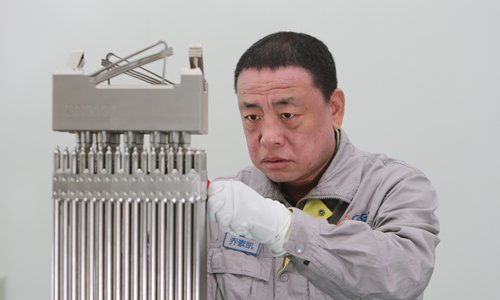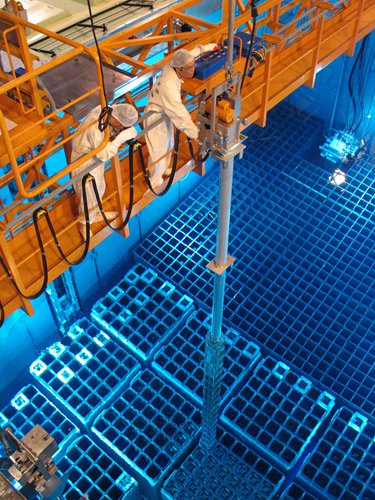HOME >> CHINA
Nuclear ‘heart surgeon’ ensures safety of China’s power plants
By Li Lei Source:Global Times Published: 2019/8/15 19:38:40

A pool of boric acid water in the Daya Bay Nuclear Power Plant, with nuclear fuel assemblies at the bottom Photo: Courtesy of CNOC
Deep inside the Daya Bay Nuclear Power Plant is a pool of limpid water. Four meters under this are 157 groups of nuclear fuel assemblies. Each assembly is comprised of 264 nuclear fuel rods, fueling nuclear fission power generation.
"Nuclear fuel is uranium-235 with a concentration of 3 percent," Qiao Sukai, a senior nuclear fuel engineer of the China Nuclear Power Operations Co Ltd (CNOC), told the Global Times. CNOC provides nuclear fuel replacement and repair services for the Daya Bay Nuclear Power Plant.
"After being processed into fuel blocks, the radioactive substance is put into a rod. A group of rods make up a fuel assembly, and 157 of these assemblies are installed into a container 3 to 4 meters in diameter," said Qiao.
The Daya Bay Nuclear Power Plant, in Shenzhen, South China's Guangdong Province, uses pressurized water reactors. Every 18 months, a third of the 157 fuel assemblies are replaced with new ones.
Qiao, 47, is responsible for everything related to fuel energy, including reception, inspection, installing, uninstalling and repairing. Out of the 45 nuclear power generation units, Qiao and his team replace and repair nuclear fuel assemblies for 23 of them, which is more than half of China's nuclear power generation units.

Qiao Sukai inspects a nuclear fuel assembly. Photo: Courtesy of CNOC
No mistakesNuclear fuel is the heart of a nuclear power plant, and Qiao's job is often likened to that of a plant's heart surgeon.
Qiao told the Global Times that the pool of water contains boric acid to shield radiation, and nuclear fuel replacement and repairing must be done underwater.
Qiao uses a four-meter carbon fiber stick with a stainless steel tool in the end to do the work four meters under the water. To remove a fuel assembly, 24 special bolts with fine threads have to be removed, which means the operator has to meet strict requirements for accuracy.
"We cannot afford to make even a tiny mistake during this process," Qiao told the Global Times. Work cannot continue if a bolt thread gets stuck. Once the bolt is damaged, the fuel assembly cannot be installed into the reactor, which results in losses of more than 6 million yuan ($857,000).
Qiao can complete the whole process with the stick and control the accuracy to within 3.7 millimeters by hand.
"The nuclear fuel rod wall is as thin as 0.53 millimeters, and I can make sure the rod is in perfect condition for withdrawing," said Qiao.
Qiao has been dealing with nuclear fuel ever since China's first commercial nuclear power plant went into operation in 1994. In the past 26 years, Qiao and his team have operated a total of 60,000 steps of work procedures without making a single mistake.
Qiao told the Global Times that the stick weighs 10 kilograms, and it takes one minute to remove a bolt. "The operator relies on arm strength to handle the stick, as the buoyancy barely helps."
"During the overhaul, the fuel rods have to be taken out and put back within the stipulated time as the power plant has to restart at a set time, so we have to work 24 hours in four shifts a day without a day off," Qiao told the Global Times.
There is no bathroom in the working area, so Qiao and his colleagues have to manage without going to the toilet while keeping their concentration. Every nuclear fuel operator has their own way of dealing with this challenge. Qiao drinks "coffee porridge" - two bags of instant coffee with a small amount of water - to help him keep awake and avoid using the bathroom.
If an unforeseen situation occurs, the working time will be longer. Qiao remembered that during one overhaul, the last nuclear fuel rod could not be put back for some reason. It took him four hours to put it back that day instead of the regular 20 minutes.
For the sake of safety, Qiao had no other option but to try every single millimeter until the rod was perfectly installed, regardless of how long it took.
In another overhaul, Qiao found a piece of debris near the nuclear fuel assembly, which is absolutely prohibited in the pool. Qiao decided to take it out. However, as they were preparing to take it out, the debris disappeared. After 15 hours of searching, the debris was spotted in a corner. It was a plastic chip the size of a fingernail.
"Although the 15 hours of searching for the debris caused a loss of 8 million yuan, it prevented a hazardous situation at the power plant," said Qiao, adding that nuclear safety is the top priority.

Engineers work by the pool of boric acid water in the Daya Bay Nuclear Power Plant. Photo: Courtesy of CNOC
Self-dependentWhen the Daya Bay Nuclear Power Plant first went into commercial operation, fuel replacement, fuel assembly repair, equipment and core technology were controlled by French companies as the reactors and nuclear fuel were imported from France.
"In 2008, when a foreign expert was invited for a training session on the fuel assembly and equipment repair, I was thinking that a training session is so expensive. It costs millions of yuan, why can't we develop our own tools for nuclear fuel assembly maintenance?" Qiao said.
Since then, Qiao and his team have focused on tool development for nuclear fuel assembly replacement and maintenance.
Qiao has dedicated himself to developing and optimizing tools and techniques in nuclear fuel assembly replacement and repair, from a hook holding cameras to a fishing tool resembling an adult's arm. These technologies are currently widely used in China.
In 2009, Qiao developed a light-conducted video camera at half the price of those imported from abroad, which has a shorter supply cycle and better after-sales service.
In 2017, Qiao established China's first nuclear fuel operation and maintenance workshop, serving as a platform to develop advanced nuclear fuel operation and maintenance techniques and equipment.
In 2018, Qiao completed China's first and only complete set of underwater nuclear fuel assembly replacement equipment and techniques in 2018, which he dubbed a "cross-century project." The techniques and equipment have been successfully applied in some nuclear power plants in China, saving tens of millions of yuan in imported equipment.
A total of 25 projects Qiao led or participated in have obtained national patents, such as underwater lighting, video camera and robots for radioactive conditions.
"It's like we can drive an imported car but cannot fix it," Qiao said, comparing nuclear power generation to an imported vehicle. "Now we are free from dependence on other countries and make repairs with our own tools and techniques."
Newspaper headline: Safe pair of hands
RELATED ARTICLES:
Posted in: PROFILE